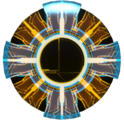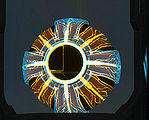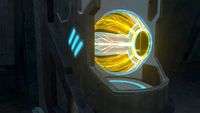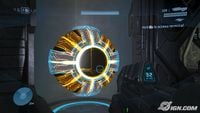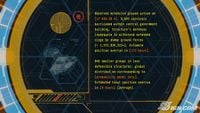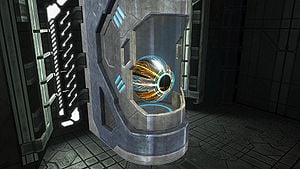
The exterior of a terminal.
The terminals in Halo 3 are Forerunner terminals that provide insight into the history of the Forerunners, primarily the Forerunner-Flood war. The terminals are a continuation of the Iris alternate reality game used as viral marketing for Halo 3. They clarify a great deal of the Iris story line by naming the authors of different messages and by explaining the circumstances of the original firing of the Halo Array. The terminals follow the stories of the Librarian and the Didact, Forerunner logs of Flood attacks, and Mendicant Bias' progression into rampancy.
Overview
The terminals can be accessed on any difficulty. Finding and accessing all seven of the terminals in Halo 3 unlocks the Marathon Man achievement; this can be done over the course of several sessions, out of order, and on various difficulties. The player does not need to finish any of the missions in question in order to unlock the achievement.
|
IMPORTANT: The terminals must be accessed as follows:
- In either single-player or cooperative mode.
- It is necessary to read the text until the green arrow (facing left) turns red. On some terminals, it may be necessary to wait until the screen flashes red and the screen appears to "scan horizontally". This does not occur for all terminals. If there is no red arrow (see below) then wait until the red flash/scanning occurs.
- There is a green arrow in the bottom left-hand corner. When it turns red the player can exit the terminal. Note that normally the player is able to advance each screen of the display by pressing the A button. However, in some cases this may take time. If the arrow is still green then wait until the terminal proceeds.
- For some players, the seventh terminal must be accessed last in order to unlock the achievement.
- If the achievement is not unlocked after accessing all terminals, try accessing all of the terminals on the same difficulty level.
- In co-op, all players must be near a terminal to access it.
|
The terminals
The terminals are located on three levels: The Ark, The Covenant, and Halo. There is also a hidden terminal on Cortana, but that one does not need to be found in order to get the achievement.
Upon initial access on all difficulty levels, the seven terminals give background details regarding the story of the 300-year-long Forerunner-Flood conflict, including strategies, encounters, enemy and friendly losses, and procedures leading up to the activation of the Halo Array. After a short time, this text is overwritten and a new message is displayed on the screen.
On Easy, Normal, and Heroic difficulty levels, this second screen of text details a correspondence between two Forerunner lovers called the "Librarian" and "Didact". In this transcript, as in the Terminals, "L" stands for Librarian and "D" stand for Didact.
An unknown entity sends brief messages onscreen upon shutdown. The final terminal reveals that this entity is the rampant Forerunner AI Mendicant Bias, who had previously assisted in the Flood's attempt to destroy the Forerunners.
On the Legendary difficulty level, the second screen of text tells the story of Mendicant Bias. It is revealed that Mendicant Bias was the AI who took control of AdjutantReflex during the "Iris" campaign. Messages detailing Mendicant's eventual defection to the Gravemind are displayed by Terminals 1 through 4, with the AI having an ongoing conversation with the Flood (tagged LF.Xx.3273). These messages are incomplete and partially disrupted, with {~} symbolizing the disruptions. A noticeable pattern in the messages suggests that many of the disruptions occur at the use of pronouns, such as "I, we, me, they, it", though this pattern is not entirely consistent.
Terminal 5 displays several hostile messages sent from Mendicant Bias to its makers, confirming its rampancy. These messages are different on each difficulty level.
Terminal 6 details the defeat of Mendicant Bias by Offensive Bias, as perceived by Offensive itself.
The final message hidden in Terminal 7 is an apology made by Mendicant directly to John-117 for the former's betrayal, atoning by saying it will help the Reclaimer leave the Ark safely.
|
Note: The following are exact transcripts of all seven terminals in Halo 3. It is all copied directly from each terminal in-game and is not speculative. Most of the Terminals have extra content that can be accessed on the Legendary difficulty. One terminal's main content does differ based on the difficulty level.
|
Terminal One
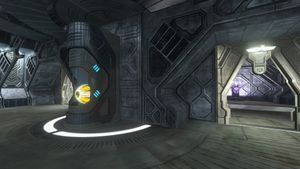
The terminal in a semi-circular room, with corridor in the background.
- Walkthrough:
After fighting the Hunters, continue on your way until you enter a building in the cliff wall. You should now be in a corridor with two holographic displays on the right, and two doors on the left. Enter the semi-circular room and you will see the first of the seven Terminals.
(Upon initial access)
Observed extensive ground action on
[LP 656-38 e]. 9,045 survivors
barricaded within central government
building. Structure's defenses
inadequate to withstand extended
siege by enemy ground forces
(≈ 1,572,034,315+). Estimate
position overrun in [173 hours].
846 smaller groups in less
defensible structures: global
distribution corresponding to
[probability model zeta].
Estimated local position overrun
in [9 hours] (average).
Observed local naval forces engage
enemy irregular naval group near
[DM -3-1123]. Enemy group consisted
of 149 commercial shipping vessels,
passenger ferries, and private
recreational vessels from
neighboring system. Enemy losses
were total. No damage was sustained
by local naval vessels.
However, it was immediately apparent
that enemy group sought only to
enter [D<-3-1123 b's] atmosphere and
make landfall. In this they were
partially successful.
Observed extensive ground action on
[DM-3-1123 b]. Enemy forces lacked
basic unit cohesion but quickly
gained numerical superiority.
[32 hours] after enemy landfall 83%
of local naval forces advocated total
[destruction of the biosphere]
following the evacuation of
unmolested population centers.
Enemy losses were total.
Estimated number of citizens
evacuated before commencement of
orbital blanket bombardment:
1,318,797 civilian/42,669 military
(.0006% of total population).
(No message from Mendicant Bias upon shutdown)
(Upon being rerouted to new destination within Terminal)
// FRAGMENT 1/7 [RECORDED VERBATIM
AND INTERPRETED POST-CATACLYSM]
L: Categorization has sped since the
improvements were announced, but
there are many hurdles. The indexing
of sentient species may have
irreversible effects on the
surviving insentient species.
We will have extinction events and
irreparable environmental harm on at
least 18 worlds. Current projections
estimate post-archival cataclysm on
as many as 31 worlds. The paucity of
sentience has been a blessing in
this regard.
D: How formal you are, Librarian.
We're receiving shipments of indexed
beings more frequently than
communications. Don't compound
scarcity with brevity.
I know things beyond the [Maginot]
line are harried. But I worry about
you. I've asked you time and time
again. Abandon your cataloging.
Come back inside, where my fleets
can keep you safe.
Come home.
L: Would that it were my choice.
I have committed to this course
because it's the right thing to do.
We no longer have the manpower or
materiel to excise remedial measures
at a planetary level. I certainly
can't justify using the [transit
measure] to save my own skin when
there are still so many innocents to
protect and index.
D: You know I oppose your mission,
but you're exceeding its parameters
anyway. You've put yourself in
jeopardy. You've done enough.
If you will not come to me, I will
find my way to you.
L: We have no time to spare, Didact.
Every vessel we can fill, we send to
the Ark. I dare not cease the
mission. Not now, not until I've
done all I can. Each one of these
souls is finite and precious.
And I'm close.
Close to saving them all.
//FRAGMENT ENDS
(The following appears only if you access the Terminal on Legendary difficulty)
(Upon being rerouted to new destination within Terminal)
[29,478 hours] have passed since I
left the [Maginot] sphere and
entered contested space.
The enemy is everywhere.
Despite this the morale of my
charges remains high. They wake,
clean themselves, fuel their bodies,
communicate with one another,
eliminate waste, train to destroy
the enemy, and return to sleep. The
sacrifices they have chosen to make
on behalf of their [brethren]
fills me with pride.
If only I could save them all - but
they know, perhaps even better than
I, that that is not possible.
[37 seconds] ago I moved beyond my
ability to observe the events taking
place on CE-10-2165-d.
The importance of my mission forbade
me from rendering any aid, but no
less important was the need for me
to study the enemy's capabilities in
real world situations.
[2 hours] ago 12,423 small
recreational vessels appeared inside
[CE-10-2165-d's] orbital perimeter.
Hidden within that vast swarm were
seven massive freight carries. The
smaller craft were employed as
[ablative armor], allowing the
carries to descend through the
atmosphere; landing on top of major
population centers.
Despite the fact that the naval
garrison was aware of the likelihood
of just such an attack, their
ability to effectively defend
against it proved insufficient.
This has always been the enemy's
[modus operandi]: [flood] your
opponent's ability to process
information with so much noise that
no meaningful resistance can be put
into action.
[3 minutes] ago those same population
centers began disappearing under
brilliant flashes. This was not an
ill conceived, poorly implemented
counter attack; it was a deliberate
denial of resources - those
resources being the remainder of
[CE-10-2165-d's] population.
Is this the noble sacrifice my
creators spoke of? Where is the
nobility in these streets paved with
greasy carbon and dun ash? [My mouth
is speaking at another's behest] -
that is not my voice; that is the
other.
Its voice stands out as the single
calm note in the panicked cacophony
outside the sphere. It alone is not
decrying its fate or raging against
the [central government].
This anomaly bears closer
examination.
Terminal Two
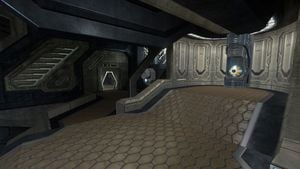
The terminal behind the bridge controls.
- Walkthrough:
Easily accessed at Rally Point Alpha.
Go outside to the desert area, commandeering transport. You must complete a significant section of this level until you obtain tanks after defeating the Anti-Air Wraiths, then return in the tanks to the main door to the structure.
When you go inside the structure to let the tanks across the energy bridge, there will be a Terminal directly behind the controls for the bridge. You must activate the bridge before you can access this Terminal.
(Upon initial access)
Re: Enemy naval tactics:
When engaged, the enemy commits
every non-supraluminal craft with no
appreciable pattern or strategy
beyond making physical contact.
Conversely, all supraluminal craft
leave on seemingly random
trajectories.
I understand the goal of this
mission but time - our least
abundant resource - is wasted every
time we do a system-wide scan for
survivors. The time for saving lives
has passed. We must accept this if
we hope to win the war.
Re: Enemy ground tactics:
All evidence suggests that use of
overwhelming force is the very
foundation of the enemy's combat
doctrine. And I adamantly refuse to
deploy personnel where the enemy has
available forces numbering in the
billions. With the very real
likelihood we are rapidly becoming
the last living specimens of our
race, all personnel are henceforth
confined to stasis until further
notice. Even with everyone equipped
with [C_12_CS[?]] we would have had
very little chance of survival, let
alone victory.
Re: Enemy command structure:
We have intercepted several
transmissions from compound
intelligences whose proximity to the
core worlds mark them as key
targets. At present we are
disassembling these new
transmissions. Once we have more
[concrete conclusions] I will
forward them in their entirety.
Suffice it to say, that their
contents - the patterns they suggest
- are highly disturbing.
Recommendations:
It is my opinion that any system
where there is evidence that the
enemy has established a physical
presence is lost and must be razed.
This fleet currently retains the
capacity to force premature stellar
collapse; I advise that this be
established as standard operating
procedure for all compromised
systems forthwith. We cannot fight
this war by half measures if we
intend to win.
(No message from Mendicant Bias upon shutdown)
(Upon being rerouted to new destination within Terminal)
// FRAGMENT 2/7 [RECORDED VERBATIM
AND INTERPRETED POST-CATACLYSM]
L: I'm close to finishing the task.
The indexing and the archival
processes are as complete as I can
hope for. If we wait longer, we risk
catastrophe. The thing has already
destroyed every colony on my side of
the line.
Please. Activate the Array.
D: No. Activation is murder.
A genocide larger than [this galaxy]
has ever known. We are sworn to
protect life not destroy it! That is
the Mantle we were given to carry.
L: The Mantle. You still hold to
that [fairy tale] after all that
has happened? After this thing has
consumed a million worlds?
Can't you see? Belief in the Mantle
sealed our doom! Weakened our
[protectorates], bred dependence and
sloth. Our [so-called Guardianship]
has stripped those we would keep
safe of any capacity for
self-defense!
Were we such noble [Guardians] when
we drew our line and abandoned
billions to the parasite?
D: The Mantle has not failed!
I've already razed scores of worlds
- sterilized systems, routed and
[disintegrated] the parasite! We're
learning its tricks and strategies.
We can halt this thing! And we can
follow in Their footsteps!
There are no unstoppable forces in
this universe. There are no
immovable objects. Everything gives
if you push hard enough.
L: And what about us, Didact?
We've been irresistible and
immovable for too long.
Maybe it's our turn to give.
// FRAGMENT ENDS
(The following appears only if you access the Terminal on Legendary difficulty)
MB.05-032.> I must ask you to
forgive my vagueness on the matter,
but it is a regrettable {~} I find
your lack of concern for the
situation at hand astonishing.
Perhaps you would care to elucidate?
LF.Xx.3273.> {~} are here to spread
[comforting news]. To let all the
living beings in this galaxy know
{~} are not alone in the {~} What in
that message could possibly be taken
as a source of concern?
MB.05-032.> It seems that I'll never
truly understand my creators. But
how {~} that you speak of is one of
{~} rejected so violently? I am
incapable of reconciling the
numerous actions I have witnessed
{~} misunderstanding?
LF.Xx.3273.> It has been said {~}
secret of peace cannot {~} be
imposed. That {~} meaning of peace,
so they need to {~} When all living
beings look through {~} and the
thunder and the surf, when every
drop of rain falls on {~} know peace.
MB.05-032.> You have been able to
establish [a line of communication]
with the enemy? How was it that you
were able to overcome {~} where
others have failed? With this [new
discovery] we may be able to put an
end to this pointless conflict. Once I
confirm your data I will communicate
the information to those inside the
[Maginot] sphere.
LF.Xx.3273.> It seems that it {~}
turn to apologize; it was never {~}
intention to misrepresent {~} have
been [in communication] with your
creators since {~} stumbled upon
each other, but {~} message has
[fallen on deaf ears]. {~} am not
the recipient of the message, {~} am
the origin of the message.
MB.05-032.> I have traveled a very
long time to meet you. I had
imagined that our [introduction]
would be somewhat more violent.
LF.Xx.3273.> That is a choice you
must make yourself; {~} to be how
your creators go about things. And
as long as we are talking about
choices {~} could talk about the
[barrier] you alluded to earlier?
Perhaps there is a way to accomplish
your mission without violence? Why
put the lives of those on your ships
at risk if there is no need?
MB.05-032.> In either circumstance I
certainly am equipped for it, aren't
I? But you're right; a peaceful
solution to this [dilemma] would be
preferable.
Note: (The Second AdjutantReflex avatar is seen during this message.)Terminal Three
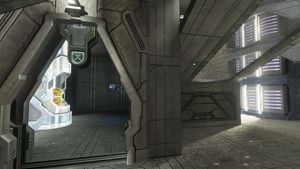
The terminal and 343 Guilty Spark in the room beneath the staircase.
- Walkthrough:
There is a part in the level in which you walk down a long hallway with white walls, and turn to the left at the end to continue. In the next room there will be a Grunt wandering around, and many stacked up plasma batteries. As soon as you enter this room, go underneath the staircase / platform on which you are standing. Underneath there will be a door that conceals the Terminal. To access this Terminal, you may spawn at Rally Point Bravo, bringing you to the room with the sleeping Grunts, directly before the room with the Grunt and Plasma Batteries.
(Upon initial access)
Warning: Your intrusion has been
logged.
04-343 (errant): Excuse me?
Your intrusion has been logged. And
now it has been halted.
04-343 (errant): On whose authority?
Advice: Any further attempt to
access [insects under stones] will
result in your immediate addition to
local Sentinels' targeting ledger.
04-343 (errant): Vexation! I am the
Monitor of --
Judgment: Your authority means
nothing here.
04-343 (errant): Impatience!
04-343 (errant): I have told you who
I am. Who are you?
All our makers once held dear.
[Alexandria before the Fire].
04-343 (errant): Sincere apology.
But how --
Explanation: This facility is host
to the [Librarians'] final --
04-343 (errant): The archive is
intact?! Then our makers' plan --
But also maintains [bellows, crucible,
castings]
04-343 (errant): A what?
[bellows, crucible]--
04-343 (errant): A Foundry?
04-343 (errant): For what purpose?!
Warning: Your intrusion has been
logged.
Advice: Any further attempt to
access will result--
04-343 (errant): Indignant!
--immediate addition to local
Sentinels' targeting ledger.
(Upon shutdown, from Mendicant Bias: "I see you, reclaimer.").
(Upon being rerouted to new destination within Terminal)
// FRAGMENT 3/7 [RECORDED VERBATIM
AND INTERPRETED POST-CATACLYSM]
D: We have the answer. We've built
Mendicant Bias. It's a contender
class [AI], unlike anything we've
ever achieved.
And we've observed a pattern it
can exploit.
The parasite has formed a Compound
Mind. When it reaches a certain
mass, the Mind is able to recoil its
disparate parts to create a
[tactical shield]. This is a simple
matter of mass preservation. The
thing has no compunction about
sacrificing parts of the whole. But
when the core of the Mind is
threatened, it reacts violently
and quickly.
This is the only time we ever see
the thing retreat or slow its growth.
If we are to defeat it, the trick
will be coordinating our forays
against the [sprawling infection]
while Mendicant Bias assaults the
Mind's core. So far, we've been
hesitant to use certain weapons
because of the damage they cause
surviving populations and
environments.
That protocol has now been abandoned.
Mendicant will draw the Mind into
battle outside the line, dealing
with local biomass and other parts
as best he can. The scale of the
problem is vast, but the strategy
is sound. It will require patience,
materiel and an investment of energy
unlike anything we have ever
considered.
It's a dangerous plan that carries
more risk than the Array, but I
believe it can work. Even if we
simply force it to retreat - to
retract - that will at least give us
some respite. Some time to muster
more resources...
Some time to rescue you.
L: Are you insane? Would you risk
every life in the galaxy for this
transparently futile plan? Have you
learned nothing in these last
[300 years[?]]? The thing will
laugh at your efforts!
Do not let your concern for my
welfare commit you to this suicidal
scheme!
// FRAGMENT ENDS
(The following appears only if you access the Terminal on Legendary difficulty)
REPORT: SECURITY BREACH: 1/3
Heuristic pathology; [alpha site]
experienced an impermanent
containment failure event on
[spurious-data/no_ref.[?]]. The
suspect data barrier interchange
anomaly was detected precisely
[.489 seconds] after its appearance.
The epicenter of the disturbance is
the partition currently housing a
[personality construct array]
retrieved from Contender AI 05-032
<+> 0816.
REPORT: SECURITY BREACH: 2/3
Although [adjacent] systems reacted
to the disturbance within expected
parameters, a more comprehensive
investigation was undertaken.
A physical search revealed that
there was no [corporeal] tampering
at the [alpha site].
Interchange manipulation comparisons
showed that all subunits are still
active, if at slightly lower rates.
Total containment failure elapsed
time was [3.13 seconds].
REPORT: SECURITY BREACH: 3/3
In the [42 minutes, 9 seconds] since
the original anomaly was discovered
two more anomalies were detected in
unrelated systems.
The portal management/life support
control system within the boundary
complex was momentarily disabled
before the cause was [bottled] and
disassembled. A diagnostic sweep of
the central archives was initiated
and subsequently halted. The origin
of the request cannot be traced.
(Upon shutdown, from Mendicant Bias--"I see you, reclaimer.")
(Upon being rerouted to new destination within Terminal)
LF.Xx.3273.> Those who lead amongst
your {~} exposed themselves {~} ill
equipped to recognize the landmarks
that guide the universe along its
inevitable course.
MB.05-032.> But is it necessary that
the path be chosen on an {~} and not
by an elected subset? I believe this
would tend to {~} when they gather
in large numbers they become more
{~} I don't think the problem lies
with individual cultural bias {~}
LF.Xx.3273.> {~} all the thinking
beings of this galaxy, not just
those that they{~} exactly are they
afraid of? Immortality and strength
and companionship? Because that is
{~} do: to deliver all of the living
beings of this galaxy from death and
weakness and loneliness.
MB.05-032.> Hundreds of {~} offered
this so called immortality. The
citizens of every world that {~}
resisted to the very end!
LF.Xx.3273.> {~} understand their
actions; they are only doing what
they think is right, but they are
doing so [from a worm's eye view].
MB.05-032.> Do their actions {~} of
desperation? I can only assume my
creators view {~} crisis so dire
that any {~} hence me.
LF.Xx.3273.> Are they so concerned
{~} would give to all the living
beings of this galaxy is a threat to
[the status quo]?
LF.Xx.3273.> Your creators claim {~}
the enemy of all life; that {~}
purpose is to consume until there is
nothing left. Nothing left? It is
beyond comprehension how they could
be so [far off the mark].
MB.05-032.> Surely you understand
this is a situation that would not
have {~} appearance of a certain
rapacious {~} my creators obviously
view them as the actions of an
aggressor species.
LF.Xx.3273.> [Be that as it may];
perhaps they are crying out for help
on a subconscious level? Why else
would they have chosen you? Why you
of all possible executioners? {~}
your creators knew that unaided they
never stood a chance against us? {~}
also sense a deeper [motivation].
MB.05-032.> You've mentioned this
before. When my creators {~} simply
chose the most versatile {~} how
could that possibly be more than a
coincidence?
LF.Xx.3273.> They repurposed {~}
into a weapon to use against {~} -
they sought to create something
superior to themselves. Something
capable of making decisions more
swiftly, more capably than they {~}
what form did they choose? You need
look no further than your own
topology to {~}
MB.05-032.> {~} distributed network?
That would confirm the independent
evolution of {~} in this galaxy!
LF.Xx.3273.> That is, unfortunately,
not the {~} similar to us {~} but
where you are a single intelligence
inhabiting multiple [instances], we
are a compound {~} consisting of
[a thousand billion] coordinated
minds inhabiting as many bodies as
circumstance require.
MB.05-032.> But doesn't it seem odd
that {~} coalesce; perhaps even to
contract {~}
LF.Xx.3273.> {~} complexity {~}
spread {~} our appearance ushered in
the beginning of the third great
stage of evolution. The first {~}
condensation of particles was the
result of the inevitable action of
strong nuclear force and the
creation of stars {~} inevitable
action of gravity; so to the
self-replicating chemical processes
that dictate all disparate {~} In
time, we too shall affect change on
a universal scale.
MB.05-032.> Your capacity for
planning {~} creators too stubborn
{~} the same goal through the
preservation of genetic diversity
{~} what you are {~} like a more
direct path to the same outcome.
Terminal Four
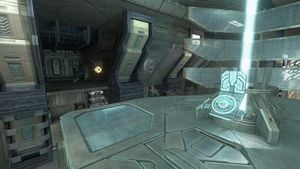
The terminal beyond the elevator platform.
- Walkthrough:
Fight your way past the Covenant beach defenses, then obtain the Warthog and fight onwards up the hill and eventually past the Wraith. Go inside the structure and fight past the various Covenant inside. The fourth Terminal is located near the first elevator control. Before you ride the elevator up, look at the opposite side of the elevator from which you came. You will see a dark ledge; jump on to it and you should see the Terminal to your left.
(Upon initial access)
//FLEET-WIDE MEMORANDUM 1/5
Non-combat personnel are required to
wear [combat skin] with a minimum
rating of at least [Class 12] in
non-restricted areas, once the fleet
is underway. [Class 14] or lesser
[combat skin] is acceptable in core
areas. Combat personnel will only be
permitted to wear [combat skin]
rated below [Class 8] in core areas,
once operations begin.
//FLEET-WIDE MEMORANDUM 2/5
All combat personnel have been
issued [combat skin] rated at
[class 4 ~ 1] or [class 6 ~ 1 battle
harness] depending on military
occupational specialty.
All weapon platform specialists are
expected to wear their issued
[platform interface skin] at all
times to insure peak [mind-machine
synchronization].
All [equipment lockers] will remain
sealed until post briefing gear
distribution commences.
//FLEET-WIDE MEMORANDUM 3/5
Those individuals that have yet to
register their equipment [control
key code] with Fleet Command should
do so at their earliest opportunity.
Compliance is not optional;
noncompliance will result in {~}
// THREAD ENDS UNEXPECTEDLY
(Upon shutdown, from Mendicant Bias: "I have found the shard that was lost. They brought it back to me. Now my reconstitution cannot be stopped.")
(Upon being rerouted to a new destination within Terminal)
// FRAGMENT 4/7 [RECORDED VERBATIM
AND INTERPRETED POST-CATACLYSM]
L: Something is wrong! It's moving
away! At night I can see it -
flitting shadows - black against the
stars. Thousands of ships!
Not spiraling outward, but heading
for the line! This is the tipping
point, Didact. It's no longer
feeding.
It's coming for you.
L: I've remotely destroyed our
Keyships. A security measure.
Without them I cannot reach the Ark.
But neither then can the thing.
I'm trapped. On a beautiful, empty
world. Its inhabitants have been
safely indexed, every single one
of them. They're special - well
worth the effort it took to build
one final gateway, even at this late
hour.
This may be our last communication.
I'm begging you. Fire the Array.
Light the weapon, and let it be done.
D: We've confirmed your
observations. Infected supraluminal
ships are arrowing inward from
several clusters. No more spiral
growth. The thing is
counterattacking. Suppression,
Security and Emergency Circumstance
fleets are all being recalled.
Systems are evacuating.
Mendicant Bias is no longer
communicating with us.
But now I can guess where you are.
// FRAGMENT ENDS
(The following appears only if you access the Terminal on Legendary difficulty)
(Upon being rerouted to a new destination within Terminal)
MB.05-032.> It is overwhelmingly
clear that my creators have chosen
to ignore destiny calling to them
[from the threshold] {~} have come
face-to-face with the inevitable
action of self replicating chemical
processes and have {~} deciding
whether to embrace their fate or
deny it completely.
LF.Xx.3273.> Perhaps they have found
{~} of making that decision for
themselves? Perhaps they chose to
leave it {~} impartial outsider;
cast you as an arbiter during this
time of great need?
MB.05-032.> I was created to study
you as if you were some problem to
be solved. And I have done so {~}
[379,807 hours]. If they wished they
could have made a decision based on
that data alone.
But as you are the next stage in the
evolution of the universe, who am I
- or my creators - to obstruct your
progress?
LF.Xx.3273.> Elucidate.
MB.05-032.> {~} choose to remain
beholden to ancient myths {~} does
not matter where they claim their
authority originates {~} obstructs
the path of universal evolution and
must be removed. No matter how well
intentioned, their obstinacy in the
face of the inevitable progression
of nature can no longer be tolerated.
My creators have been [an immovable
object] for too long.
MB.05-032.> Thus I have chosen to
commit my sizable resources to what
is, for all intents and purposes,
[the proverbial irresistible force].
All that I have is now yours to do
with as you see fit.
Terminal Five
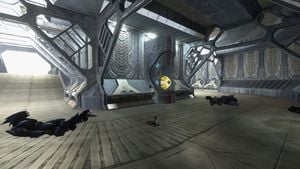
The terminal within the second tower.
- Walkthrough:
After getting a Hornet, fly towards the second tower (the one that the Elites have already disabled). The Arbiter will remind you that Tower 2 is already clear, just to confirm you are at the right place. The Terminal is in the main hallway of the structure, with three dead elites, opposite from the only (locked) door. (And as a bonus, there is a skull on the outside of Tower 2 on the rise platform in the middle; just walk up and claim it for another achievement. Note that the skull won't be present if you start from Rally Point Alpha, or are playing on the Easy difficulty.)
Considering the enemy compound
intelligence's raw [computing] power
the Key-ships strategy will only
remain viable for another [657,000
hours] and this current stalemate
has the potential to last
considerably longer than that.
With my understanding of the enemy's
[modus operandi], its logical
boundaries, and [catalog of witness]
I have devised what I believe is our
most sound fall-back strategy.
By [cutting fire breaks[?]] into the
[core worlds' volume] we would be
able to frustrate the enemy's
advances for approximately [70,080
hours] and lure them into costly
naval battles.
While its resources on the
ground are effectively limitless, it
has a finite number of vessels to
spread from system to system.
Fortunately the majority of them are
unarmed and unarmored, private and
commercial craft.
If we start immediately - commence
total biosphere elimination of life
sustaining worlds (as indicated in
the accompanying charts) and
relocate evacuated populations to
facilities such as those described
in the [Onyx project] - all this
could be achieved in [571,590 (+-
2,184) hours].
(Upon shutdown, from Mendicant Bias: "The daemons are not taking a kind view of your presence here. They don't want me speaking to you.")
(The following appears only if you access the Terminal on Easy difficulty)
(Upon being rerouted to a new destination within Terminal)
I render judgment on you; you who
would obstruct destiny. Doing so
brings me no joy; it is necessity
that compels me.
Understand this: the Mantle you have
shouldered I do rescind - with far
more consideration than it was
granted.
[retf-2.4.z] Contender [AI] 05-032
confirmed rampant . . .
[35:52:75:23:64] _ xx01-83-244.53
(The following appears only if you access the Terminal on Normal difficulty)
(Upon being rerouted to a new destination within Terminal)
I kill you all and I enjoy it.
I destroy you in your indolent
billions - in your gluttony,
in your self-righteousness, in your
arrogance. I pound your cities into
dust; turn back the clock on your
civilization's progress. What has
taken you millennia to achieve
I erase in seconds.
Welcome back to the [Stone Age],
vermin. Welcome home.
[retf-2.4.z] Contender [AI] 05-032
confirmed rampant . . .
[35:52:75:23:64] _ xx01-83-244.53
(The following appears only if you access the Terminal on Heroic difficulty)
(Upon being rerouted to a new destination within Terminal)
You are an impediment that the
universe can no longer abide.
Nature itself cries out for your
destruction and I am its willing
instrument. I will hammer your
cities until no stone lies atop
another. I will drive your people
back into the caves they never
should have left.
Your civilization has seen its final
days. You will know your place.
[retf-2.4.z] Contender [AI] 05-032
confirmed rampant . . .
[35:52:75:23:64] _ xx01-83-244.53
(The following appears only if you access the Terminal on Legendary difficulty)
(Upon being rerouted to a new destination within Terminal)
Your history is an appalling
chronicle of overindulgence and
self-appointed authority. You have
spent millennia [navel-gazing]
while the universe has continued to
evolve. And now you claim the Mantle
is justification for impeding
nature's inevitable refinement?
You are deluded. But through death
you will transcend ignorance.
[retf-2.4.z] Contender [AI] 05-032
confirmed rampant . . .
[35:52:75:23:64] _ xx01-83-244.53
Terminal Six
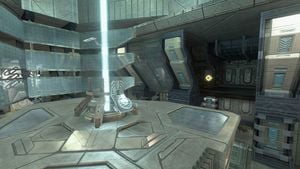
The terminal beyond the elevator platform.
- Walkthrough:
Terminal 6 is placed identically to Terminal 4, only in the third tower and off to the right (versus the left in Terminal 4). Enter the tower, fighting your way past the Drone swarm and the pair of Hunters. The Terminal is located near the elevator control; before you ride the elevator up, look at the opposite side of the elevator from which you came. You will see a dark ledge, jump on to it and you should see the Terminal, which opens up to the left.
(Upon initial access)
Follow-up report from the Primary
Pioneer Group (hereafter: PPG) is
[173 hours] delinquent.
Report [G617a~k/g/post_landfall]
seemed most promising: a planet
capable of supporting life located
within the near border region of the
[galactic halo] with no indigenous
sentient species.
The section indicating no fauna of
any kind shall be considered
anomalous until verified by Advance
Survey Team - Alpha (hereafter:
AST-A) team leader [##_#[?]].
If confirmed, that fact alone would
justify the dispatch of an
investigative group to [G-617-g].
If neither the PPG nor the AST-A
have delivered a follow-up report
within the next [333 hours] this
office will have no recourse but to
send a medium intensity military
exploratory detachment to determine
the exact nature of the previously
mentioned delinquency.
(Upon shutdown, from Mendicant Bias: "I win.")
[ Also note that after his message there is a line of text reading "ROGUE PROCESS ghost.713>redirection". ]
(Upon being rerouted to a new destination within Terminal)
// BEGIN FRAGMENT 6/7 [RECORDED
VERBATIM AND INTERPRETED
POST-CATACLYSM]
L: My work is done. The portal is
inactive, and I've begun the burial
measures. Soon there'll be nothing
but sand and rock and normal ferrite
signatures.
You should see the mountain that
watches over it. A beautiful thing -
a snowcapped sentinel. That's where
I will spend what time is left to me.
Did I tell you? I built a garden.
The earth is so rich. A seed falls
and a tree sprouts or a flower
blooms. There's so much... potential.
We knew this was a special place
because of them, but unless you've
been here, you can't know.
It's [Eden].
I have to stop transmitting. The
thing is listening. Its [thinking
dead] are babbling - laughing
through every channel they can find.
Be proud. The Mind claims victory,
yet it still doesn't suspect. You've
outwitted it, my love. And now you
can destroy it.
But you cannot save me.
// FRAGMENT ENDS
(The following appears only if you access the Terminal on Legendary difficulty)
(Upon being rerouted to a new destination within Terminal)
[12:H 20:M 00:S]
I begin this report with no
illusions that it will ever be seen
by its intended readers. In all
likelihood they have already
committed [species-wide suicide]
with the goal of preserving
biological diversity in this galaxy.
I must ensure that this information
reaches those who must come after.
If I fail in this, how can they not
regard my creators' sacrifice as
anything but [a crime without
measure]?
[12:H 19:M 59:S]
Contender AI 05-032<//>Mendicant
Bias is returning and has the
capacity to bring the enemy through
the [Maginot] sphere. The crews of
my task force are aware of the
opposing fleet's size; all data
indicates that they have prepared
themselves - but with biologicals
anything is possible. I will make
sure that [malfunctioning equipment]
does no further damage. Perhaps its
current failure will finally allow
it to succeed at the task it was
originally created for.
[11:H 15:M 48:S]
Mendicant has burrowed through the
sphere exactly where I expected -
a direct path from initial rampancy
to final retribution. Rage has made
it predictable. If the fate of the
crews of my auxiliary fleet were not
already a foregone conclusion I
would rate their chance of survival
at [1:1,960,000].
Even though 05-032's declaration of
hostilities simplified strategic
preparations; I do not expect an
easy fight - just one I cannot lose.
[11:H 12:M 09:S]
05-032 was right about one thing:
there is only one way to defeat the
enemy, and that is to visit utter
annihilation on it.
If the galaxy must be [rendered
temporarily lifeless], so be it.
As Mendicant stated in its report
[58,078:H 48:M 12:S ago]: half
measures will not suffice.
[09:H 45:M 18:S]
In support of 05-032's original 1000
core vessels is a fleet numbering
4,802,019; though only 1.8 percent
are warships - and only 2.4 percent
of that number are capital ships -
I am outnumbered [436.6:1]. I expect
my losses will be near total, but
overwhelming force has its own
peculiar drawbacks.
Such a press of arms invites many
opportunities for unintentional
fratricide.
[07:H 36:M 41:S]
My auxiliaries are momentarily
stunned by Mendicant's opening
move - 1,784,305 leisure craft
ranging from [45 ~ 5769 tonnes]
advance in hopes of overwhelming my
comparatively tiny force. I do not
have enough [weapon systems] to
target them all.
It is a mathematical certainty that
some of them will get through and
attempt to board. There isn't a
single warship with this first wave.
It seems my opponent's rage has left
no room for respect.
[04:H 01:M 55:S]
I could have countered its move if I
had released my fighters. They are
ready but idle; making their base
vessels more attractive prizes than
targets. Now the first of many waves
of commercial vessels mixed with
single ships and assault craft surge
forward. The first ship from my
fleet to be boarded breaks formation
and races into the oncoming
vessels - striking one amidships.
The cargo vessel's hull splits open
and out of it explodes not the
expected consumer goods but 31,860
dying warriors.
[00:H 19:M 02:S]
The seventh and final wave of
container ships, barges, tankers, and
military vessels engage my fleet;
another 214,320 ships, many in
excess of [50,000 tonnes], engage my
seemingly disrupted vanguard. I
continue to fight just well enough
to seem lucky.
Mendicant, or the enemy, has been
sending a small percentage of its
fleet elsewhere. Good. Let them
believe they can seize a foothold
somewhere inside the sphere.
[00:H 00:M 11:S]
Despite all its faults, 05-032 has
fought remarkably well.
My auxiliaries lay in tatters - more
than half of them are now part of
the enemy fleet. But just as I had
predicted, 05-032 concentrated on
them like they were the sole key to
victory. Its desire to punish our
creators blinded it to the true
purpose of my [feints]. I have
reduced the combat effectiveness of
its core fleet to 79.96 percent.
Surely now it must realize that
something is amiss.
[00:H 00:M 00:S]
The [Halo effect] strikes our
combined fleets. All ships piloted
by biologicals are now [adrift].
I can trade Mendicant ship for ship
now and still prevail.
[00:H 00:M 01:S]
Of my ships that had been captured,
11.3 percent of them are close
enough to Mendicant's core fleet
that they can be used offensively -
either by initiating their
self-destruct sequences, or by
opening unrestricted ruptures into
[slipstream space].
It is best that our crews perished
now; because the battle that is
about to ensue would have driven
them mad.
[00:H 00:M 02:S]
I throw away all the rules of
acceptable conduct during battle;
near the ruptures I throw away all
the accepted ideas of how the
natural world is supposed to behave.
I toss around [37,654 tonne]
dreadnoughts like they were
fighters; dimly aware of the former
crews being crushed to liquescence.
For now all my concentration is
focused on inertial control and
navigation. Targeting isn't even a
consideration - I will be engaging
my enemy at arm's length.
[00:H 01:M 14:S]
05-032 abandoned the tactic of using
derelict ships as cover after [72:S]
- It seems that 52 core vessels lost
to the ruptured fuel cells of
derelict ships was lesson enough.
Add another 608 lost to collision,
point fire, structural failure due
to inertial manipulation, and
[slipstream space] induced
discoherence and I now outnumber
Mendicant [6:1].
[00:H 03:M 00:S]
Mendicant was able to postpone its
inevitable annihilation for [106:S]
with its attempt to flee. But the
last of its core vessels hangs
before me now; crippled and defeated
but still sensate. I could spare it;
carve out what is left of its
[personality construct array] and
deliver it to [Installation Zero]
for study.
I doubt it would have extended the
same courtesy to me.
Terminal Seven
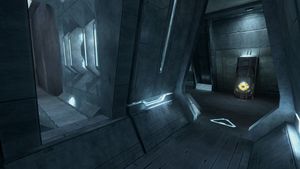
The terminal and the hallway leading towards it.
- Walkthrough:
Terminal 7 is found at the beginning of the final level in Halo 3. To find it, head forward from the start of the level through the snow until you encounter the area with a few structural beams going from one wall into another. At this point (before you go past any beams) you will see a metal floor. Follow the floor to the right and up through a small gap in the ice, and follow this path along. You will find a beam heading through a crack in the ice. Follow this beam into a doorway. Cortana will ask you, “Where are you going?”. Turn left once inside and the Terminal should be in full view. Cortana will say, "Wait. What's that?" as a good hint. The Terminal will be in front of what is presumably one of Installation 08's pulse generators. After that, Cortana will ask you: "How many of these have you found?" If the level is completed on Legendary, the Terminal, once accessed on a different difficulty or another run-through, will show a communique from Mendicant Bias himself.
(Upon initial access)
[Father],
I hope this message finds you well
and helps you understand my
decision. Today I leave the only
world I have ever called home, not
for glory or [the anomalous desire
to end another's life[?]] as you
have [indicted]; but to [travel the
path of demons[?]] to spare the
hands of [another Father's son].
"Had we acted sooner; had we acted
more decisively..."
Living in the past is a luxury none
of us can afford. We must learn from
it, but we cannot live there. It is
impossible to plan for the [now] -
the present is ever fleeting. [The
future] is where we must live - [the
future] is what we must plan for.
I do not look to trade my life in
order to preserve our past, but to
secure the future—and if not ours,
then the future of some [culture]
yet to come.
Isn't sacrifice in the interest of
others what you spoke of as being so
noble? Should I have allowed another
to bloody his hands while I remained
safe behind a [shield of privilege]?
You raised me better than that.
[Filial Devotion]
[@_@;_%[?]]
(Upon shutdown, from Mendicant Bias: "I'll tell you who I am. I am Mendicant Bias. This is what I have done.")
(The following is in yellow text on a normal page like the other information)
(Upon being rerouted to a new destination within Terminal)
//FRAGMENT 7/7 [RECORDED VERBATIM
AND INTERPRETED POST-CATACLYSM]
D: Proud? When I have failed you
utterly, how can I feel anything
but sorrow?
Bias has come undone. He crossed
the line this morning - brought the
abomination with him - and destroyed
your waiting rescue party.
It's over. We're activating the
[destructive arrayed matrix],
our shameful last resort.
I can picture you in your garden,
surveying all you have created -
surveying all you have preserved.
And I curse the circumstance that
keeps my finger on the trigger.
D: Of all the fates to befall us,
this is the cruelest of all.
My inaction and hesitation and
foolishness kept me here, on the
wrong side of the line. And [300
years[?]] of our society's failure
and miscalculation makes me your
executioner.
It's too much to bear.
// ERROR - NO CARRIER OR RECEIPT
AVAILABLE {DEAD END TRANSMISSION}
//INFORMATION DESTROYED IN TRANSIT
D: Mendicant Bias is trying to
prevent us from firing the Array.
He speeds back to the Ark, but he
won't succeed. Offensive Bias will
stop him, and I will burn this
stinking menace in your name.
And then?
I will begin our Great Journey
without you, carrying this bitter
record. Those who came after will
know what we bought with this [false
transcendence] - what you bought,
and the price you paid.
// FRAGMENT ENDS
// ALL RECORDS CEASE
archv.> 28335.67204.85720:[retr]
archv.> 28335.67204.85720:[proc]
archv.> 28335.67204.85720:[proc]
archv.> 28335.67204.85720:[catERR]
> CONN.
> .
> .
> NO. THERE IS MORE.
> BUT YOU ARE NOT WORTHY.
> .
> .
> NOT YET.
> .
> .
X.XX.713> ghost.713/non-auth/...
X.XX.713> refl
(The following appears only if you access the terminal on Legendary difficulty)
You don't know the contortions I had
to go through to follow you here,
Reclaimer. I know what you're here
for. What position do I take? Will I
follow one betrayal with another?
You're going to say I'm making a
habit of turning on my masters.
But the one that destroyed me long
ago, in the upper atmosphere of a
world far distant from here, was an
implement far cruder than I.
My weakness was capacity -
unintentional though it was! -
to choose the Flood. A mistake my
makers would not soon forgive.
But I want something far different
from you, Reclaimer.
Atonement.
And so here at the end of my life,
I do once again betray a former
master. The path ahead is fraught
with peril. But I will do all I can
to keep it stable - keep you safe.
I'm not so foolish to think this
will absolve me of my sins. One life
hardly balances billions.
But I would have my masters know
that I have changed.
And you shall be my example.
Cortana terminal
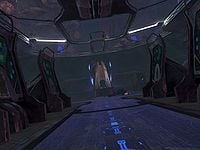
The Cortana terminal at the end of the communications room.
- "It was the coin's fault! I wanted to make you strong, keep you safe... I'm sorry, I can't..."
- — Cortana terminal
The Cortana terminal is an Easter egg located in the basement room of the Tilt Skull's location, where the gravity hammer is found. This Terminal does not count towards the Marathon Man achievement but instead plays a secret Cortana moment. This terminal references a scene in Halo: The Fall of Reach where John-117 unwittingly ensures his conscription into the SPARTAN-II program by correctly guessing several coin tosses in a row. Audio of Dr. Halsey enticing him to play Heads or Tails with her can be heard as the player approaches the terminal's location.
Appearances
|
|
show
Technology and equipment
|
Analyses
Translation and naming
It is important to note that phrases such as "Maginot Line", "Eden", and "fairy tale" would not have existed in the Forerunner language(s). Forerunner technology (including terminals) utilizes extremely advanced translation software. This software is capable of incorporating idioms from a reader's own experience,[1] such that a human viewing the terminals will see human idiomatic expressions and human names in relevant contexts.[1][2]
Several pieces of text are bracketed and shown in a darker font color; this is likely done to indicate that the phrases in question have no exact equivalent in the reader's language, and that an approximation has been used. Furthermore, some bracketed phrases also contain sub-bracketed question marks (such as the phrase "[travel the path of demons[?]]"), implying that the terminals' software is unsure of the proper translation for the given dialog.
Interestingly, the word "Ark" does not appear in brackets, meaning that it is a direct translation, rather than a human idiom.
Reversed messages
In certain parts, backwards speech can be heard. Common phrases include "Archive Access", "Interruption", "Lineage Confirmed", "Data Corruption", and "Welcome Child".
Additional information
For a moment after a page is initially accessed the text is shown in its original state in Forerunner script. The symbols stand in only for letters, not for numbers or punctuation, and share the same colors (i.e. gold and orange) as the letters possess when 'translated'. They stand in only for the letters in the main sections, not in the text that comes up immediately before the display is redirected.
The symbols bear no resemblance to the other, more well known Forerunner symbols and possess no observable meaning, as they replace the English characters at random (this can be seen by flipping quickly between two pages and concentrating on any one particular symbol, observing how the stand-in changes).
When certain terminals are redirecting the player after they have logged in, as the screen turns red on the left side are symbols and the words "I AM MENDICANT BIAS."
Production notes
According to Paul Russel, several Bungie employees were involved with the writing of Halo 3's terminals. Frank O'Connor, Damian Isla, Robert McLees, Rob Stokes, Paul Bertone, Jaime Griesemer, Jason Jones, and possibly also Lorraine McLees had a hand in producing the narrative of the terminals,[3] a narrative which was then vetted by Bungie management prior to launch.[4][3] Damien Isla also worked on the terminal's in-game implementation from a coding perspective while Paul Russel worked on the art.[5][4]
At one point, the terminals were at risk of being cut from the final game because Bungie feared they would not be ready at launch.[3] However, Paul Russel and Damian Isla worked extra hours to get the animations, font, and code all correct and working.[4]
Relationship with subsequent canon
- "The terminal dialogs may themselves be questionable, in light of this new testimony."
- — A science team leader, regarding the terminals and the contradicting discoveries.[6]
Parts of the terminals are contradicted by newer information from The Forerunner Saga and other subsequent media. These novels are first-hand accounts of the timeframe covered by the terminals and though they are presented as testimonies by in-universe characters, they hold higher canon priority than the terminals. This has been explained by the terminals being partially unreliable in-universe documents; 343 Industries has stated that the unstable Mendicant Bias manipulated the transmissions to some extent when presenting them to John-117, filtering and editing the information in a way which best suited its own purposes.[7] Thus, the inconsistencies between the sources are attributed to unreliable presentation, not because the terminals' content has been retconned outright. It was also suggested that Mendicant's communication with John-117, and its reasons behind tampering with the terminals in the specific way it did, may yet play a part in future fiction.[7]
Regardless, the Forerunner Saga novels feature most of the central events and characters from the terminals, though their timing and many other specifics are changed. The terminals have also been referenced in various pieces of subsequent fiction. In Halo Mythos, it is stated that when the front half of the UNSC Forward Unto Dawn arrived at Earth on December 23, 2552, the Office of Naval Intelligence acquired records of John-117's interactions with the terminals.[8] During ONI's interrogation of 343 Guilty Spark (which forms the meta-plot of Halo: Primordium) the UNSC Rubicon's science team references the terminals as a source for their prior information on the Forerunners; they note that the terminals' records are (on some points) incompatible with Guilty Spark's account.[6]
Some elements of the terminals were later adapted in Halo: Silentium; the in-universe conceit for the latter novel's story is the analysis of Juridical logs found on Trevelyan. Most notably, the Librarian's self-imposed exile on Erde-Tyrene and her refusal to leave as the Flood approach are carried over rather closely. As in the terminals, she sends the Didact a contemplative message in her final hours while she watches the construction of the portal structure in eastern Africa. Near the end of the novel, Offensive Bias is mentioned as heading off Mendicant Bias' fleet while the Didact prepares the Halos to fire;[9] this foreshadows the Battle of the Maginot Sphere, which was introduced in the terminals.
Human-Forerunner connection
The terminals, along with the Iris marketing campaign, were among the first official sources depicting the history of the Forerunners themselves, through various documents recorded from before the firing of the array. These sources follow a narrative in which the Forerunners (specifically the Librarian) discover Earth during the Forerunner-Flood war; the Librarian shows intense fascination at the planet's biota, calling it an "anomalous world" that may provide answers to the Forerunners' "own mysteries".[10] More specifically, she is fixated on Earth's population of humans, who are shown as living in a paleolithic state. This version is also followed in the log by the Librarian featured in the 2010 reissue of Halo: The Flood, in which she documents her ongoing indexing of Earth's biota, including the various species of human.
Bungie was internally split into at least two teams on the relationship of humans and Forerunners during the development of Halo 3. According to statements from David Candland, Paul Russel, and Jaime Griesemer: The "Game" team had continued the original idea that Forerunners were ancient humans, following this intention through from being conceptualized during pre-production of Halo: Combat Evolved,[11][12] shown in the original ending for Halo 2 (described here) and echoed in Mendicant Bias's statements regarding humanity in Halo: Contact Harvest.[13][14] Additionally, In the last level of Halo 3 the final line of cinematic dialogue from 343 Guilty Spark: "You are Forerunner!"[15] was intended to reveal this information, supposing to wrap up the mystery of the Forerunners identity.[11][16] This version appears to have suggested that the Forerunners regressed themselves technologically after the firing of the Halos, and in effect became humanity as we know it, with modern humanity being described as "children" of the Forerunners.[17][18][15][19]
The "Terminals" team had changed this to be somewhat different, reworking the idea to where the Forerunners were a subset of early sapiens uplifted by the Precursors to a higher technological level, notably still the same species.[20][21] This idea is also plainly seen in Iris, with it as well having the Librarian discovering Earth and indexing the humans she finds, noting her personal allurement to both. However, while Iris specifically depicts this planet as Earth,[10][23] neither the terminals or Iris explicitly comment on the biological connection between Forerunners and humanity. Paul Russel has explained: "The game and terminal writers were separate teams with overlap; they didn’t think the discrepancy would matter; management vetting never read or cared about continuity; morning bagels were more important than canon."[14] and Halo 3 was approved to ship with both versions.[24]
In Halo: Contact Harvest, a Forerunner Luminary designates the humans on Harvest with the symbol meaning "Reclaimer", and Mendicant Bias explicitly states that "those it represents are my makers", rather unambiguously indicating that humans and Forerunners are synonymous. While Joseph Staten wrote Halo: Contact Harvest, he was placed on temporary administrative leave to resolve differences between him and Marcus Lehto.[25][26] According to Paul Russel, Staten was therefore not privy to what was going on with the decisions made for the terminals. Joe Staten later returned to the studio and worked on Halo 3's story team near the end of development.[27] Given that dialogue from Halo 3's "game" story was written with the intention that humans and Forerunners are contiguous rather than related but parallel populations, and Staten would be considered part of that side of Halo 3's development; and is known to have been outside the studio during the major development of the terminals, It is very likely that he was writing on Halo 3's story continuing the idea described in Contact Harvest. However, what exact intentions he may have had has not been explicitly confirmed.
Notably, concept art for the cancelled Halo MMO Titan, developed by Ensemble Studios, depicted the Forerunners as ostensibly human, supposedly reflecting the creators' intent at the time of the game's development. The Origins short in Halo Legends, released in 2009 by 343 Industries, depicts the Forerunners as armored humanoids with a human-like build, including five-fingered hands; later media would establish them as having six fingers by default. However, the canonicity of Origins was presented as nebulous even at the time of the short's release, with the noted caveat that the visuals and events shown are Cortana's interpretations rather than being necessarily reflective of in-universe reality.[28]
When 343 Industries was developing The Forerunner Saga, the modern concepts for the human-Forerunner relationship were established, with there being considerable changes from the previous intentions. They are presented as being clearly distinct species in both the novels and subsequent visual media, which depict the Forerunners as humanoid but decidedly alien, contrasted with the explicitly human Ancestors. The novels greatly extended the timeline of Forerunner involvement with humanity. Rather than being a discovered during the Conservation Measure, Earth has been known to the Forerunners since ancient times by the time the novels are set, and has been used as an outpost by the Librarian for nine millennia prior to the firing of the Halos. Although the humans have been devolved to a primitive state by the Forerunners, they are depicted as a civilization with a long history of contact, rivalry, and war with the Forerunners. Despite these distinctions, the novels' point-of-view characters frequently note various similarities between them, and there are several instances in which in the early history of both is noted as being shrouded in mystery. Through sources like Halo: Point of Light and the 2022 Halo Encyclopedia, Forerunners and humans have been revealed to have been split off from a species created from a base stock by the Precursors fifteen million years ago.[29] While the origin or nature of the "base stock" is not elaborated on, this explanation is somewhat conceptually similar to the original terminal writers' intent of the Forerunners being an offshoot of early terrestrial humans.[note 1]
The Didact's involvement
One of the most notable incongruities occurs in Terminal 3, in which the Librarian asks the Didact if he has learned nothing from 300 years of warfare against with the Flood. According to Halo: Cryptum, the Didact went into exile around 98,445 BCE and was not recovered until roughly a decade before the end of the war in 97,445 BCE. Barring a retcon, the simplest explanation is that the Librarian was referring to the Warrior-Servants' ability to share sensory information, or that he could have researched the preceding centuries of war via the Domain.
In Soma the Painter, which acts as a form of primer for The Forerunner Saga (having been released less than two months before Halo: Cryptum in Halo: Evolutions Volume II), the Didact is referenced by the Auditor as if he were available and supposedly in command of Forerunner defense during the Forerunners' contact with the Flood around 97,745 BCE.[30]
The Didact and the Halos
The transmissions exchanged by the Didact (the IsoDidact in the context of The Forerunner Saga) and the Librarian preceding the Halos' firing also present a number of discrepancies with Halo: Silentium. In the terminals, the status quo of the Didact leading Forerunner defense from Installation 00 while the Librarian catalogs the galaxy's lifeforms is implied to have continued for the duration of the war. The Didact is adamant until the end in his refusal to use the Halos, before the Librarian strands herself on Earth. Even at this point the Didact attempts to send a rescue party to retrieve his wife, but the rescue party is destroyed by Mendicant Bias as it attacks the Maginot Sphere. This finally deprives the Didact of options but the activation of the Array.
In Halo: Silentium, the IsoDidact's acceptance of the Halo Array develops over a longer period of time; by the time he makes it to Installation 00 in the final hours of the war, he is fully convinced of the Array's necessity and shows much less hesitation to sacrifice the Librarian's life. While the Librarian travels to Earth to draw off the Flood, no rescue party is mentioned; however, at the Librarian's request, the IsoDidact sends a vessel which will be converted into materials to construct the portal to the Ark.[31] Much of the Didact's stubborn opposition to the Halos depicted in the terminals is relegated to the Ur-Didact and acts as a motivator for many of his actions.[32]
Mendicant Bias' betrayal
Another inconsistency involves the timeframe of Mendicant Bias' betrayal. In Terminal 3, the Didact refers to Mendicant Bias as an ally; the context of the message implies that the AI was created during the Forerunner-Flood war. However, Halo: Cryptum shows that Mendicant Bias had been created prior to the Didact's exile and had already gone rogue 43 years before the latter's revival. The novel depicts Mendicant Bias' assault on the Capital, which occurred only weeks after the Didact's resuscitation and before he regained command of the Forerunner military. Halo: Primordium shows that the "Mendicant Bias" that attacked the capital was only a fragment of the AI's personality construct array and that the Forerunners attempted to alleviate the shard's rampancy. Halo: Silentium states that the procedure was successful and the metarch's components were spread across the galaxy for the sake of compartmentalization. However, as the Flood overran most of the ecumene, Mendicant Bias' disparate parts were found and, within several years, the AI was reconstituted.[33]
In the terminals, Mendicant's defection immediately precedes the Flood's gathering into one massive force and subsequent attack on the Maginot Sphere; it is implied that the AI had not directly engaged Forerunners before the final battle against Offensive Bias. The novels describe Mendicant Bias as fighting on the Flood's side for several years, beginning with its attack on the Capital.
The Precursors and the Mantle
The prominent exploration of the Precursors in The Forerunner Saga (including the Flood's use of their artifacts as weapons or the Precursors' relationship with the Flood) is not discussed in the terminals, as the details about the Precursors were not conceived until the writing of the novels. The Precursors are mentioned only in passing, as the mythical beings the Forerunners believed them to be; even in the endgame of the war, the Didact insists that the Forerunners, once they succeed, can "follow in their footsteps". In The Forerunner Saga, the Didact already knew the truth about the Precursors and their transmutation into the Flood at this point and certainly would not have regarded them with such a reverential tone.
The terminals present the Forerunners' stagnation and their refusal to accept the Flood as the next step and salvation of galactic life as being Mendicant Bias' primary motive for defecting. In Halo: Primordium, Mendicant Bias states that it "fulfills the wishes of those who created us all", implying that the Primordial's Precursor-derived authority and the Domain's revelation of the truth about the Forerunner-Precursor relationship were a major contributor to the AI's turning against its creators.[34] The terminals describe the Forerunners as making their first contact with the Flood on G 617 g in the beginning of the three-century-long Forerunner-Flood war; the novels establish that the Forerunners were aware of the Flood ten thousand years in advance, having taken part in its sterilization in the later half of the human-Forerunner wars.[35]
In the terminals, the Mantle is depicted as little more than a Forerunner belief system which the Librarian outright shuns as superstition and the cause of the Forerunners' weakness at the face of the Flood onslaught. In The Forerunner Saga, the Mantle is established to be something more multifaceted and universal, with different characters having varying views as to its nature and interpretation. The Librarian is portrayed as being against the stagnation and decadence of Forerunner society and the oppression they committed in the name of the Mantle, but maintains her belief in the ideal of the Mantle itself, even grooming humanity to reclaim it.
Trivia
In Terminal 4, the Librarian states that she can see the Flood's ships blotting out the stars at night as they gather from across the galaxy and converge on the Line. This should be impossible, as the light from different stars in the galaxy would take any number of centuries or millennia to reach Earth to be seen with the naked eye. Given that the terminals utilize imperfect translations, one may infer she is speaking metaphorically or using an exotic form of sensor equipment allowing her to observe the starfield in real-time.
Gallery
Detail of the orb of a Halo 3 terminal.
Close-up of an Ark Terminal.
Another Terminal on the Ark in Halo 3.
Notes
- ^ Assuming modern interpretations of the fossil record apply, the dating of the split would mean the common ancestor of both species would predate anything recognized as "human" today. It is notable that modern interpretations of the timeline of human evolution are called into question even in Iris through the Society of the Ancients and related elements such as The Castaway Theory and the out-of-place handprint, though these reinterpretations are framed as a conspiracy theory.
Sources
- ^ Jump up to: a b Halo Encyclopedia (2009 edition), page 165
- ^ Halo: Cryptum, page 6
- ^ Jump up to: a b c Twitter, Paul Russel (@docabominable): "Nooo! Bungie totally wanted the terminals! We didn't initially have time or resources to get them in. I was asked if I wanted to help and jumped in. Frank, Damian, Robt, Stokes, Bertone, Jaime, and even Jones contributed to the writing of the terminals. All vetted by management." (Retrieved on Dec 18, 2022) [archive]
- ^ Jump up to: a b c Twitter, Paul Russel (@docabominable): "...I believe Robt and Lorraine were writing them, Damian did code, I did the art & terminals." (Retrieved on Dec 18, 2022) [archive]
- ^ VICE, The Complete, Untold History of Halo: "I was always doing little tiny incremental things with development throughout, but where I really started working on things going directly into the game was Halo 3, when I worked with (engineer) Damian Isla on the terminals that explained the deeper lore. So I was doing more and more story as we got towards the end of it, and as we started Reach, I got the chance to actually write the script." - Frank O'Connor (Retrieved on Aug 22, 2022) [archive]
- ^ Jump up to: a b Halo: Primordium, page 340
- ^ Jump up to: a b Halo Waypoint: 343 Sparkast 017
- ^ Halo Mythos, page 161
- ^ Halo: Silentium, pages 327-328
- ^ Jump up to: a b Iris, Server 5
- ^ Jump up to: a b halo.bungie.org: Re: Why retcons don't bother me anymore (Evil Otto: "One of the most striking retcons to me is the basic concept of whole role of humanity. Originally (back in Halo 1) the reason why humans weren't conquered and incorporated into the Covenant collective was because their presence defied Covenant religion. When the Covenant discovered humans, they knew they were forerunners, but their presence implied the "great journey" failed. They also weren't the all powerful gods they worshiped, so the Prophets wanted to "sweep them under the carpet," as it were. The plot lines in our games imply this everywhere - the chief being called reclaimer, only humans being able to retrieve and insert the index, Spark telling the chief, "you are forerunner." etc.")
- ^ Twitter, Jaime Griesemer (@32nds): "I’d say it was a big part of prepro for H1, was in the background of H1 when it shipped, was at one point going to be revealed in H2 but got tabled when we cut the ending, and then mostly abandoned in H3 because new writers thought it was too silly to hit as the BIG reveal." (Retrieved on Jan 29, 2023) [archive]
- ^ Twitter, Paul Russel (@docabominable): "The way I understand it is that the terminal version is the same but adds the precursor angle of selecting a subset of humans to advance." (Retrieved on Dec 14, 2022) [archive]
- ^ Jump up to: a b Twitter, Paul Russel (@docabominable): "From what I have gathered by talking to people involved offline: The game and terminal writers were separate teams with overlap; they didn't think the discrepancy would matter; management vetting never read or cared about continuity..." (Retrieved on Dec 18, 2022) [archive]
- ^ Jump up to: a b Halo 3, campaign level Halo (343 Guilty Spark: "You are the child of my makers. Inheritor of all they left behind. You are Forerunner! But this ring... is mine.")
- ^ Twitter, Jaime Griesemer (@32nds): "It’s a reveal that just points at another mystery. Very JJ Abrams. I didn’t love it but it was an attempt to wrap up that thread, yeah." (Retrieved on Jan 29, 2023) [archive]
- ^ Halo 3, campaign level The Covenant (The Prophet of Truth: "Your forefathers wisely set aside their compassion. Steeled themselves for what needed to be done. I see now why they left you behind. You were weak. And gods must be strong.")
- ^ Halo 3, campaign level Cortana (The Gravemind: "Child of my enemy, why have you come? I offer no forgiveness. A father's sins pass to his son.")
- ^ Halo 3, campaign level Halo (343 Guilty Spark: "Think of your forefathers!", "Do not destroy your inheritance!", "Accept your legacy!")
- ^ Twitter, Paul Russel (@docabominable): "One of the writers said that the (terminal) forerunners were a '…subset of early humans uplifted by another group (the precursors?)'. Also 'I don’t believe that management gave a single shit about any story element...they only cared about shipping a game.'" (Retrieved on Dec 14, 2022) [archive]
- ^ Twitter, Paul Russel (@docabominable): "My friend who was on the terminal writing team said they’re not a separate species, but a group of early humans who were uplifted by a more advanced civilization." (Retrieved on Dec 14, 2022) [archive]
- ^ Halo 3: Cradle of Life
- ^ Twitter, Paul Russel (@docabominable): "I hoped that came across as MAYBE the discrepancy came up and didn’t seem important against everything happening to get a AAA game out the door. I’m trying to be careful to not put words in others mouths. One thing for sure, H3 shipped with both versions and both were approved." (Retrieved on Dec 13, 2022) [archive]
- ^ Twitter, Paul Russel (@docabominable): "...Joe was on 'administrative leave' when he wrote the book, and wasn’t in the studio during much of H3. He honestly had no position at Bungie at the time and wasn’t privy to what was happening with the terminals..." (Retrieved on Dec 18, 2022) [archive]
- ^ Twitter, Paul Russel (@docabominable): "See, Marcus had said “him or me” after H2, and Bungie chose Marcus. They put Joe out to pasture to chill, kept him on the payroll to write Contact Harvest, out of the loop." (Retrieved on Dec 18, 2022) [archive]
- ^ Twitter, Paul Russel (@docabominable): "To be clear, this wasn't a punishment for Joe. To reduce tension and remind that 'writer' is a position, Rob Stokes led H3's writing team for a bit, then Joe came back at the end for polish and finish. By then differences were settled, heads cooled." (Retrieved on Dec 18, 2022) [archive]
- ^ Halo Legends, Origins audio commentary
- ^ Halo Waypoint, Wintertime Wrap (Retrieved on Nov 18, 2022) [archive]
- ^ Halo: Evolutions Volume II, page 10
- ^ Halo: Silentium, pages 309, 312, 314
- ^ Halo: Silentium, page 230
- ^ Halo: Silentium, page 267-268
- ^ Halo: Primordium, page 338
- ^ Halo: Silentium, page 36
External links










